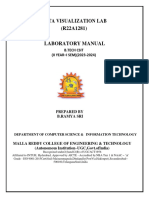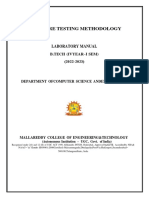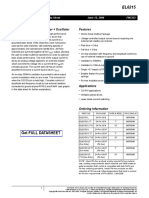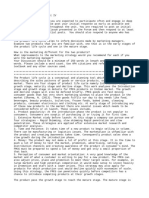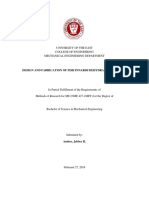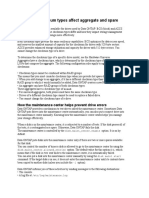Data Structures Through Python Lab Manual (R20a0503)
Uploaded by
uzairkhan18082Data Structures Through Python Lab Manual (R20a0503)
Uploaded by
uzairkhan18082DATA STRUCTURES USING PYTHON
LAB MANUAL
B.TECH
(II YEAR – I SEM)
(2021-22)
DEPARTMENT OF COMPUTER SCIENCE AND ENGINEERING
MALLA REDDY COLLEGE OF ENGINEERING & TECHNOLOGY
(Autonomous Institution – UGC, Govt. of India)
Recognized under 2(f) and 12 (B) of UGC ACT 1956
(Affiliated to JNTUH, Hyderabad, Approved by AICTE - Accredited by NBA & NAAC – ‘A’ Grade - ISO 9001:2015 Certified)
Maisammaguda, Dhulapally (Post Via. Hakimpet), Secunderabad – 500100, Telangana State, India
DEPARTMENT OF COMPUTER SCIENCE AND ENGINEERING
Vision
• To acknowledge quality education and instill high patterns of
discipline making the students technologically superior and ethically strong
which involves the improvement in the quality of life in human race.
Mission
• To achieve and impart holistic technical education using the best of
infrastructure, outstanding technical and teaching expertise to establish the
students in to competent and confident engineers.
• Evolving the center of excellence through creative and innovative
teaching learning practices for promoting academic achievement to produce
internationally accepted competitive and world class professionals.
PROGRAMME EDUCATIONAL OBJECTIVES (PEOs)
PEO1 – ANALYTICAL SKILLS
• To facilitate the graduates with the ability to visualize, gather
information, articulate, analyze, solve complex problems, and make
decisions. These are essential to address the challenges of complex and
computation intensive problems increasing their productivity.
PEO2 – TECHNICAL SKILLS
• To facilitate the graduates with the technical skills that prepare them
for immediate employment and pursue certification providing a deeper
understanding of the technology in advanced areas of computer science and
related fields, thus encouraging to pursue higher education and research
based on their interest.
PEO3 – SOFT SKILLS
• To facilitate the graduates with the soft skills that include fulfilling the
mission, setting goals, showing self-confidence by communicating
effectively, having a positive attitude, get involved in team-work, being a
leader, managing their career and their life.
PEO4 – PROFESSIONAL ETHICS
• To facilitate the graduates with the knowledge of professional and
ethical responsibilities by paying attention to grooming, being conservative
with style, following dress codes, safety codes, and adapting themselves to
technologicaladvancements.
PROGRAM SPECIFIC OUTCOMES (PSOs)
After the completion of the course, B. Tech Computer Science and
Engineering, the graduates will have the following Program Specific
Outcomes:
1. Fundamentals and critical knowledge of the Computer System:- Able to
Understand the working principles of the computer System and its
components , Apply the knowledge to build, asses, and analyze the software
and hardware aspects of it .
2. The comprehensive and Applicative knowledge of Software
Development: Comprehensive skills of Programming Languages, Software
process models, methodologies, and able to plan, develop, test, analyze, and
manage the software and hardware intensive systems in heterogeneous
platforms individually or working in teams.
3. Applications of Computing Domain & Research: Able to use the
professional, managerial, interdisciplinary skill set, and domain specific tools
in development processes, identify the research gaps, and provide innovative
solutions to them.
PROGRAM OUTCOMES (POs)
Engineering Graduates should possess the following:
1. Engineering knowledge: Apply the knowledge of mathematics, science, engineering
fundamentals, and an engineering specialization to the solution of complex engineering
problems.
2. Problem analysis: Identify, formulate, review research literature, and analyze complex
engineering problems reaching substantiated conclusions using first principles of
mathematics, natural sciences, and engineering sciences.
3. Design / development of solutions: Design solutions for complex engineering problems
and design system components or processes that meet the specified needs with
appropriate consideration for the public health and safety, and the cultural, societal, and
environmental considerations.
4. Conduct investigations of complex problems: Use research-based knowledge and
research methods including design of experiments, analysis and interpretation of data,
and synthesis of the information to provide valid conclusions.
5. Modern tool usage: Create, select, and apply appropriate techniques, resources, and
modern engineering and IT tools including prediction and modeling to complex
engineering activities with an understanding of the limitations.
6. The engineer and society: Apply reasoning informed by the contextual knowledge to
assess societal, health, safety, legal and cultural issues and the consequent
responsibilities relevant to the professional engineering practice.
7. Environment and sustainability: Understand the impact of the professional
engineering solutions in societal and environmental contexts, and demonstrate the
knowledge of, and need for sustainable development.
8. Ethics: Apply ethical principles and commit to professional ethics and responsibilities
and norms of the engineering practice.
9. Individual and team work: Function effectively as an individual, and as a member or
leader in diverse teams, and in multidisciplinary settings.
10. Communication: Communicate effectively on complex engineering activities with the
engineering community and with society at large, such as, being able to comprehend and
write effective reports and design documentation, make effective presentations, and give
and receive clear instructions.
11. Project management and finance: Demonstrate knowledge and understanding of the
engineering and management principles and apply these to one’s own work, as a
member and leader in a team, to manage projects and in multi disciplinary environments.
12. Life- long learning: Recognize the need for, and have the preparation and ability to
engage in independent and life-long learning in the broadest context of technological
change.
MALLA REDDY COLLEGE OF ENGINEERING & TECHNOLOGY
Maisammaguda, Dhulapally Post, Via Hakimpet, Secunderabad – 500100
________________________________________________________________________
Department of Computer Science and Engineering
GENERAL LABORATORY INSTRUCTIONS
1. Students are advised to come to the laboratory at least 5 minutes before (to the starting time),
those who come after 5 minutes will not be allowed into the lab.
2. Plan your task properly much before to the commencement, come prepared to the lab with the
synopsis / program / experiment details.
3. Student should enter into the laboratory with:
a. Laboratory observation notes with all the details (Problem statement, Aim, Algorithm,
Procedure, Program, Expected Output, etc.,) filled in for the lab session.
b. Laboratory Record updated up to the last session experiments and other utensils (if any) needed
in the lab.
c. Proper Dress code and Identity card.
4. Sign in the laboratory login register, write the TIME-IN, and occupy the computer system
allotted to you by the faculty.
5. Execute your task in the laboratory, and record the results / output in the lab observation note
book, and get certified by the concerned faculty.
6. All the students should be polite and cooperative with the laboratory staff, must maintain the
discipline and decency in the laboratory.
7. Computer labs are established with sophisticated and high end branded systems, which should
be utilized properly.
8. Students / Faculty must keep their mobile phones in SWITCHED OFF mode during the lab
sessions. Misuse of the equipment, misbehaviors with the staff and systems etc., will attract
severe punishment.
9. Students must take the permission of the faculty in case of any urgency to go out; if anybody
found loitering outside the lab / class without permission during working hours will be treated
seriously and punished appropriately.
10. Students should LOG OFF/ SHUT DOWN the computer system before he/she leaves the lab
after completing the task (experiment) in all aspects. He/she must ensure the system / seat is
kept properly.
HEAD OF THE DEPARTMENT PRINCIPAL
INDEX
S.No Name of the program Page No
Write a Python program for class, Flower, that has three instance
variables of type str, int, and float that respectively represent the
name of the flower, its number of petals, and its price. Your class
1. 1
must include a constructor method that initializes each variable to an
appropriate value, and your class should include methods for setting
the value of each type, and retrieving the value of each type.
Develop an inheritance hierarchy based upon a Polygon class that has
abstract methods area( ) and perimeter( ). Implement classes
Triangle, Quadrilateral, Pentagon, that extend this base class, with
2. the obvious meanings for the area( ) and perimeter( ) methods. Write 5
a simple program that allows users to create polygons of the various
types and input their geometric dimensions, and the program then
outputs their area and perimeter.
Write a python program to implement Method Overloading and
3. 9
Method Overriding.
Write a Python program to illustrate the following comprehensions:
4. a) List Comprehensions b) Dictionary Comprehensions 13
c) Set Comprehensions d) Generator Comprehensions
Write a Python program to generate the combinations of n distinct
objects taken from the elements of a given list. Example: Original
5. list: [1, 2, 3, 4, 5, 6, 7, 8, 9] Combinations of 2 distinct objects: [1, 2] 20
[1, 3] [1, 4] [1, 5] .... [7, 8] [7, 9] [8, 9].
6. Write a program for Linear Search and Binary search. 23
7. Write a program to implement Bubble Sort and Selection Sort. 27
8. Write a program to implement Merge sort and Quick sort. 30
9. Write a program to implement Stacks and Queues. 34
10. Write a program to implement Singly Linked List. 42
11. Write a program to implement Doubly Linked list. 50
12. Write a program to implement Binary Search Tree. 58
Data Structures using Python Lab 2021-2022
1. Write a Python program for class, Flower, that has three instance variables of type str, int,
and float, that respectively represent the name of the flower, its number of petals, and its
price. Your class must include a constructor method that initializes each variable to an
appropriate value, and your class should include methods for setting the value of each type,
and retrieving the value of each type.
Program:
class Flower:
#Common base class for all Flowers
def __init__(self, petalName, petalNumber, petalPrice):
self.name = petalName
self.petals = petalNumber
self.price = petalPrice
def setName(self, petalName):
self.name = petalName
def setPetals(self, petalNumber):
self.petals = petalNumber
def setPrice(self, petalPrice):
self.price = petalPrice
def getName(self):
return self.name
def getPetals(self):
return self.petals
def getPrice(self):
return self.price
#This would create first object of Flower class
f1 = Flower("Sunflower", 2, 1000)
print ("Flower Details:")
print ("Name: ", f1.getName())
print ("Number of petals:", f1.getPetals())
print ("Price:",f1.getPrice())
print ("\n")
#This would create second object of Flower class
f2 = Flower("Rose", 5, 2000)
f2.setPrice(3333)
f2.setPetals(6)
print ("Flower Details:")
print ("Name: ", f2.getName())
print ("Number of petals:", f2.getPetals())
print ("Price:",f2.getPrice())
Department of CSE Page 1
Data Structures using Python Lab 2021-2022
Output:
Signature of the Faculty
Department of CSE Page 2
Data Structures using Python Lab 2021-2022
Exercise Programs:
Department of CSE Page 3
Data Structures using Python Lab 2021-2022
Department of CSE Page 4
Data Structures using Python Lab 2021-2022
2. Develop an inheritance hierarchy based upon a Polygon class that has abstract methods
area( ) and perimeter( ). Implement classes Triangle, Quadrilateral, Pentagon, that extend this
base class, with the obvious meanings for the area( ) and perimeter( ) methods. Write a
simple program that allows users to create polygons of the various types and input their
geometric dimensions, and the program then outputs their area and perimeter.
Program:
from abc import abstractmethod, ABCMeta
import math
class Polygon(metaclass = ABCMeta):
def __init__(self, side_lengths = [1,1,1], num_sides = 3):
self._side_lengths = side_lengths
self._num_sizes = 3
@abstractmethod
def area(self):
pass
@abstractmethod
def perimeter(self):
pass
def __repr__(self):
return (str(self._side_lengths))
class Triangle(Polygon):
def __init__(self, side_lengths):
super().__init__(side_lengths, 3)
self._perimeter = self.perimeter()
self._area = self.area()
def perimeter(self):
return(sum(self._side_lengths))
def area(self):
#Area of Triangle
s = self._perimeter/2
product = s
for i in self._side_lengths:
product*=(s-i)
return product**0.5
class Quadrilateral(Polygon):
def __init__(self, side_lengths):
super().__init__(side_lengths, 4)
self._perimeter = self.perimeter()
Department of CSE Page 5
Data Structures using Python Lab 2021-2022
self._area = self.area()
def perimeter(self):
return(sum(self._side_lengths))
def area(self):
# Area of an irregular Quadrilateral
semiperimeter = sum(self._side_lengths) / 2
return math.sqrt((semiperimeter - self._side_lengths[0]) *
(semiperimeter - self._side_lengths[1]) *
(semiperimeter - self._side_lengths[2]) *
(semiperimeter - self._side_lengths[3]))
class Pentagon(Polygon):
def __init__(self, side_lengths):
super().__init__(side_lengths, 5)
self._perimeter = self.perimeter()
self._area = self.area()
def perimeter(self):
return((self._side_lengths) * 5)
def area(self):
# Area of a regular Pentagon
a = self._side_lengths
return (math.sqrt(5 * (5 + 2 * (math.sqrt(5)))) * a * a) / 4
#object of Triangle
t1 = Triangle([1,2,2])
print(t1.perimeter(), t1.area())
#object of Quadrilateral
q1 = Quadrilateral([1,1,1,1])
print(q1.perimeter(), q1.area())
#object of Pentagon
p1 = Pentagon(1)
print(p1.perimeter(), p1.area())
Output:
Signature of the Faculty
Department of CSE Page 6
Data Structures using Python Lab 2021-2022
Exercise Programs:
Department of CSE Page 7
Data Structures using Python Lab 2021-2022
Department of CSE Page 8
Data Structures using Python Lab 2021-2022
3. Write a python program to implement method overloading and method overriding.
Method Overloading
Method overloading is an OOPS concept which provides ability to have several methods
having the same name with in the class where the methods differ in types or number of
arguments passed.
Method overloading in Python
Method overloading in its traditional sense (as defined above) as exists in other languages
like method overloading in Java doesn’t exist in Python.
In Python if you try to overload a function by having two or more functions having the same
name but different number of arguments only the last defined function is recognized, calling
any other overloaded function results in an error.
Achieving method overloading
Since using the same method name again to overload the method is not possible in Python, so
achieving method overloading in Python is done by having a single method with several
parameters. Then you need to check the actual number of arguments passed to the method
and perform the operation accordingly.
Program:
class OverloadDemo:
# sum method with default as None for parameters
def sum(self, a=None, b=None, c=None):
# When three params are passed
if a!=None and b!=None and c!=None:
s = a + b + c
print('Sum = ', s)
# When two params are passed
elif a!=None and b!=None:
s = a + b
print('Sum = ', s)
od = OverloadDemo()
od.sum(7, 8)
od.sum(7, 8, 9)
Output:
Department of CSE Page 9
Data Structures using Python Lab 2021-2022
Method overriding - Polymorphism through inheritance
Method overriding provides ability to change the implementation of a method in a child class
which is already defined in one of its super class. If there is a method in a super class and
method having the same name and same number of arguments in a child class then the child
class method is said to be overriding the parent class method.
When the method is called with parent class object, method of the parent class is executed.
When method is called with child class object, method of the child class is executed. So the
appropriate overridden method is called based on the object type, which is an example of
Polymorphism.
Program:
class Person:
def __init__(self, name, age):
self.name = name
self.age = age
def displayData(self):
print('In parent class displayData method')
print(self.name)
print(self.age)
class Employee(Person):
def __init__(self, name, age, id):
# calling constructor of super class
super().__init__(name, age)
self.empId = id
def displayData(self):
print('In child class displayData method')
print(self.name)
print(self.age)
print(self.empId)
#Person class object
person = Person('Karthik Shaurya', 26)
person.displayData()
#Employee class object
emp = Employee(''Karthik Shaurya', 26, 'E317')
emp.displayData()
Output:
Signature of the Faculty
Department of CSE Page 10
Data Structures using Python Lab 2021-2022
Exercise Programs:
Department of CSE Page 11
Data Structures using Python Lab 2021-2022
Department of CSE Page 12
Data Structures using Python Lab 2021-2022
4. Write a Python program to illustrate the following comprehensions:
a) List Comprehensions b) Dictionary Comprehensions
c) Set Comprehensions d) Generator Comprehensions
Comprehensions in Python
Comprehensions in Python provide us with a short and concise way to construct new
sequences (such as lists, set, dictionary etc.) using sequences which have been already
defined. Python supports the following 4 types of comprehensions:
a) List Comprehensions
b) Dictionary Comprehensions
c) Set Comprehensions
d) Generator Comprehensions
a) List Comprehensions:
List Comprehensions provide an elegant way to create new lists. The following is the basic
structure of a list comprehension:
output_list = [output_exp for var in input_list if (var satisfies this condition)]
Note that list comprehension may or may not contain an if condition. List comprehensions
can contain multiple for (nested list comprehensions).
Example: Suppose we want to create an output list which contains only the even numbers
which are present in the input list. Let’s see how to do this using for loop and list
comprehension and decide which method suits better.
Using Loop:
#Constructing output list WITHOUT using List comprehensions
input_list = [1, 2, 3, 4, 4, 5, 6, 7, 7]
output_list = []
#Using loop for constructing output list
for var in input_list:
if var % 2 == 0:
output_list.append(var)
print(“Output List using for loop:”, output_list)
Output:
Department of CSE Page 13
Data Structures using Python Lab 2021-2022
Using List Comprehension:
# Using List comprehensions
# for constructing output list
input_list = [1, 2, 3, 4, 4, 5, 6, 7, 7]
list_using_comp = [var for var in input_list if var % 2 == 0]
print("Output List using list comprehensions:",list_using_comp)
Output:
b) Dictionary Comprehensions:
Extending the idea of list comprehensions, we can also create a dictionary using dictionary
comprehensions. The basic structure of a dictionary comprehension looks like below.
output_dict = {key:value for (key, value) in iterable if (key, value satisfy this condition)}
Example 1: Suppose we want to create an output dictionary which contains only the odd
numbers that are present in the input list as keys and their cubes as values. Let’s see how to
do this using for loops and dictionary comprehension.
Using Loop:
input_list = [1, 2, 3, 4, 5, 6, 7]
output_dict = {}
# Using loop for constructing output dictionary
for var in input_list:
if var % 2 != 0:
output_dict[var] = var**3
print("Output Dictionary using for loop:",output_dict)
Output:
Department of CSE Page 14
Data Structures using Python Lab 2021-2022
Using Dictionary Comprehension:
# Using Dictionary comprehensions
# for constructing output dictionary
input_list = [1,2,3,4,5,6,7]
dict_using_comp = {var:var ** 3 for var in input_list if var % 2 != 0}
print("Output Dictionary using dictionary comprehensions:",
dict_using_comp)
Output:
Example 2: Given two lists containing the names of states and their corresponding capitals,
construct a dictionary which maps the states with their respective capitals. Let’s see how to
do this using for loops and dictionary comprehension.
Using Loop:
state = ['Gujarat', 'Maharashtra', 'Rajasthan']
capital = ['Gandhinagar', 'Mumbai', 'Jaipur']
output_dict = {}
# Using loop for constructing output dictionary
for (key, value) in zip(state, capital): output_dict[key] = value
print("Output Dictionary using for loop:", output_dict)
Output:
Using Dictionary Comprehension:
# Using Dictionary comprehensions
# for constructing output dictionary
state = ['Gujarat', 'Maharashtra', 'Rajasthan']
capital = ['Gandhinagar', 'Mumbai', 'Jaipur']
dict_using_comp = {key:value for (key, value) in zip(state, capital)}
print("Output Dictionary using dictionary
comprehensions:",dict_using_comp)
Department of CSE Page 15
Data Structures using Python Lab 2021-2022
Output:
c) Set Comprehensions:
Set comprehensions are pretty similar to list comprehensions. The only difference between
them is that set comprehensions use curly brackets { }. Let’s look at the following example
to understand set comprehensions.
Example : Suppose we want to create an output set which contains only the even numbers
that are present in the input list. Note that set will discard all the duplicate values. Let’s see
how we can do this using for loops and set comprehension.
Using Loop:
input_list = [1, 2, 3, 4, 4, 5, 6, 6, 6, 7, 7]
output_set = set()
# Using loop for constructing output set
for var in input_list:
if var % 2 == 0:
output_set.add(var)
print("Output Set using for loop:", output_set)
Output:
Using Set Comprehension:
# Using Set comprehensions
# for constructing output set
input_list = [1, 2, 3, 4, 4, 5, 6, 6, 6, 7, 7]
set_using_comp = {var for var in input_list if var % 2 == 0}
print("Output Set using set comprehensions:",set_using_comp)
Output:
Department of CSE Page 16
Data Structures using Python Lab 2021-2022
d) Generator Comprehensions:
Generator Comprehensions are very similar to list comprehensions. One difference between
them is that generator comprehensions use circular brackets whereas list comprehensions
use square brackets. The major difference between them is that generators don’t allocate
memory for the whole list. Instead, they generate each value one by one which is why they
are memory efficient. Let’s look at the following example to understand generator
comprehension:
input_list = [1, 2, 3, 4, 4, 5, 6, 7, 7]
output_gen = (var for var in input_list if var % 2 == 0)
print("Output values using generator comprehensions:", end = ' ')
for var in output_gen:
print(var, end = ' ')
Output:
Signature of the Faculty
Department of CSE Page 17
Data Structures using Python Lab 2021-2022
Exercise Programs:
Department of CSE Page 18
Data Structures using Python Lab 2021-2022
Department of CSE Page 19
Data Structures using Python Lab 2021-2022
5. Write a Python program to generate the combinations of n distinct objects taken from the
elements of a given list. Example: Original list: [1, 2, 3, 4, 5, 6, 7, 8, 9] Combinations of 2
distinct objects: [1, 2] [1, 3] [1, 4] [1, 5] .... [7, 8] [7, 9] [8, 9].
Program:
def combination(n, n_list):
if n<=0:
yield []
return
for i in range(len(n_list)):
c_num = n_list[i:i+1]
for a_num in combination(n-1, n_list[i+1:]):
yield c_num + a_num
n_list = [1,2,3,4,5,6,7,8,9]
print("Original list:")
print(n_list)
n = 2
result = combination(n, n_list)
print("\nCombinations of",n,"distinct objects:")
for e in result:
print(e)
Output:
Signature of the Faculty
Department of CSE Page 20
Data Structures using Python Lab 2021-2022
Exercise Programs:
Department of CSE Page 21
Data Structures using Python Lab 2021-2022
Department of CSE Page 22
Data Structures using Python Lab 2021-2022
6. Write a program for Linear Search and Binary search
Linear Search Program:
def linearSearch(target, List):
position = 0
global iterations
iterations = 0
while position < len(List):
iterations += 1
if target == List[position]:
return position
position += 1
return -1
if __name__ == '__main__':
List = [1, 2, 3, 4, 5, 6, 7, 8]
target = 3
answer = linearSearch(target, List)
if answer != -1:
print('Target found at index :', answer, 'in',
iterations,'iterations')
else:
print('Target not found in the list')
Output:
Department of CSE Page 23
Data Structures using Python Lab 2021-2022
Binary Search Program:
def binarySearch(target, List):
left = 0
right = len(List) - 1
global iterations
iterations = 0
while left <= right:
iterations += 1
mid = (left + right) // 2
if target == List[mid]:
return mid
elif target < List[mid]:
right = mid - 1
else:
left = mid + 1
return -1
if __name__ == '__main__':
List = [1, 2, 3, 4, 5, 6, 7, 8, 9, 11, 12, 13, 14]
target = 12
answer = binarySearch(target, List)
if(answer != -1):
print('Target',target,'found at position', answer, 'in',
iterations,'iterations')
else:
print('Target not found')
Output:
Signature of the Faculty
Department of CSE Page 24
Data Structures using Python Lab 2021-2022
Exercise Programs:
Department of CSE Page 25
Data Structures using Python Lab 2021-2022
Department of CSE Page 26
Data Structures using Python Lab 2021-2022
7. Write a program to implement Bubble Sort and Selection Sort
Bubble Sort Program:
def bubble_sort(alist):
for i in range(len(alist) - 1, 0, -1):
no_swap = True
for j in range(0, i):
if alist[j + 1] < alist[j]:
alist[j], alist[j + 1] = alist[j + 1], alist[j]
no_swap = False
if no_swap:
return
alist = input('Enter the list of numbers: ').split()
alist = [int(x) for x in alist]
bubble_sort(alist)
print('Sorted list: ', alist)
Output:
Selection Sort Program:
def selection_sort(alist):
for i in range(0, len(alist) - 1):
smallest = i
for j in range(i + 1, len(alist)):
if alist[j] < alist[smallest]:
smallest = j
alist[i], alist[smallest] = alist[smallest], alist[i]
alist = input('Enter the list of numbers: ').split()
alist = [int(x) for x in alist]
selection_sort(alist)
print('Sorted list: ', alist)
Output:
Signature of the Faculty
Department of CSE Page 27
Data Structures using Python Lab 2021-2022
Exercise Programs:
Department of CSE Page 28
Data Structures using Python Lab 2021-2022
Department of CSE Page 29
Data Structures using Python Lab 2021-2022
8. Write a program to implement Merge sort and Quick sort
Merge Sort Program:
def merge_sort(alist, start, end):
'''Sorts the list from indexes start to end - 1 inclusive.'''
if end - start > 1:
mid = (start + end)//2
merge_sort(alist, start, mid)
merge_sort(alist, mid, end)
merge_list(alist, start, mid, end)
def merge_list(alist, start, mid, end):
left = alist[start:mid]
right = alist[mid:end]
k = start
i = 0
j = 0
while (start + i < mid and mid + j < end):
if (left[i] <= right[j]):
alist[k] = left[i]
i = i + 1
else:
alist[k] = right[j]
j = j + 1
k = k + 1
if start + i < mid:
while k < end:
alist[k] = left[i]
i = i + 1
k = k + 1
else:
while k < end:
alist[k] = right[j]
j = j + 1
k = k + 1
alist = input('Enter the list of numbers: ').split()
alist = [int(x) for x in alist]
merge_sort(alist, 0, len(alist))
print('Sorted list: ', alist)
Output:
Department of CSE Page 30
Data Structures using Python Lab 2021-2022
Quick Sort Program:
def quicksort(alist, start, end):
'''Sorts the list from indexes start to end - 1 inclusive.'''
if end - start > 1:
p = partition(alist, start, end)
quicksort(alist, start, p)
quicksort(alist, p + 1, end)
def partition(alist, start, end):
pivot = alist[start]
i = start + 1
j = end - 1
while True:
while (i <= j and alist[i] <= pivot):
i = i + 1
while (i <= j and alist[j] >= pivot):
j = j - 1
if i <= j:
alist[i], alist[j] = alist[j], alist[i]
else:
alist[start], alist[j] = alist[j], alist[start]
return j
alist = input('Enter the list of numbers: ').split()
alist = [int(x) for x in alist]
quicksort(alist, 0, len(alist))
print('Sorted list: ', alist)
Output:
Signature of the Faculty
Department of CSE Page 31
Data Structures using Python Lab 2021-2022
Exercise Programs:
Department of CSE Page 32
Data Structures using Python Lab 2021-2022
Department of CSE Page 33
Data Structures using Python Lab 2021-2022
9. Write a program to implement Stacks and Queues
Stack Program:
# Custom stack implementation in Python
class Stack:
# Constructor to initialize the stack
def __init__(self, size):
self.arr = [None] * size
self.capacity = size
self.top = -1
# Function to add an element `x` to the stack
def push(self, x):
if self.isFull():
print("Stack Overflow!! Calling exit()…")
exit(1)
print("Inserting", x, "into the stack…")
self.top = self.top + 1
self.arr[self.top] = x
# Function to pop a top element from the stack
def pop(self):
# check for stack underflow
if self.isEmpty():
print("Stack Underflow!! Calling exit()…")
exit(1)
print("Removing", self.peek(), "from the stack")
#decrease stack size by 1 and (optionally) return the popped element
top = self.arr[self.top]
self.top = self.top - 1
return top
# Function to return the top element of the stack
def peek(self):
if self.isEmpty():
exit(1)
return self.arr[self.top]
# Function to return the size of the stack
def size(self):
return self.top + 1
# Function to check if the stack is empty or not
def isEmpty(self):
return self.size() == 0
Department of CSE Page 34
Data Structures using Python Lab 2021-2022
# Function to check if the stack is full or not
def isFull(self):
return self.size() == self.capacity
if __name__ == '__main__':
stack = Stack(3)
stack.push(1) # Inserting 1 in the stack
stack.push(2) # Inserting 2 in the stack
stack.pop() # removing the top element (2)
stack.pop() # removing the top element (1)
stack.push(3) # Inserting 3 in the stack
print("Top element is", stack.peek())
print("The stack size is", stack.size())
stack.pop() # removing the top element (3)
# check if the stack is empty
if stack.isEmpty():
print("The stack is empty")
else:
print("The stack is not empty")
Output:
Department of CSE Page 35
Data Structures using Python Lab 2021-2022
Department of CSE Page 36
Data Structures using Python Lab 2021-2022
Queue Program:
# Custom queue implementation in Python
class Queue:
# Initialize queue
def __init__(self, size):
self.q = [None] * size # list to store queue elements
self.capacity = size # maximum capacity of the queue
self.front = 0 # front points to the front element in the queue
self.rear = -1 # rear points to the last element in the queue
self.count = 0 # current size of the queue
# Function to dequeue the front element
def pop(self):
# check for queue underflow
if self.isEmpty():
print("Queue Underflow!! Terminating process.")
exit(1)
print("Removing element…", self.q[self.front])
self.front = (self.front + 1) % self.capacity
self.count = self.count - 1
# Function to add an element to the queue
def append(self, value):
# check for queue overflow
if self.isFull():
print("Overflow!! Terminating process.")
exit(1)
print("Inserting element…", value)
self.rear = (self.rear + 1) % self.capacity
self.q[self.rear] = value
self.count = self.count + 1
# Function to return the front element of the queue
def peek(self):
if self.isEmpty():
print("Queue UnderFlow!! Terminating process.")
exit(1)
return self.q[self.front]
# Function to return the size of the queue
def size(self):
return self.count
Department of CSE Page 37
Data Structures using Python Lab 2021-2022
# Function to check if the queue is empty or not
def isEmpty(self):
return self.size() == 0
# Function to check if the queue is full or not
def isFull(self):
return self.size() == self.capacity
if __name__ == '__main__':
# create a queue of capacity 5
q = Queue(5)
q.append(1)
q.append(2)
q.append(3)
print("The queue size is", q.size())
print("The front element is", q.peek())
q.pop()
print("The front element is", q.peek())
q.pop()
q.pop()
if q.isEmpty():
print("The queue is empty")
else:
print("The queue is not empty")
Output:
Department of CSE Page 38
Data Structures using Python Lab 2021-2022
Signature of the Faculty
Department of CSE Page 39
Data Structures using Python Lab 2021-2022
Exercise Programs:
Department of CSE Page 40
Data Structures using Python Lab 2021-2022
Department of CSE Page 41
Data Structures using Python Lab 2021-2022
10. Write a program to implement Singly Linked List
Program:
import os
from typing import NewType
class _Node:
'''
Creates a Node with two fields:
1. element (accesed using ._element)
2. link (accesed using ._link)
'''
__slots__ = '_element', '_link'
def __init__(self, element, link):
'''
Initialses _element and _link with element and link respectively.
'''
self._element = element
self._link = link
class LinkedList:
'''
Consists of member funtions to perform different
operations on the linked list.
'''
def __init__(self):
'''
Initialses head, tail and size with None, None and 0 respectively.
'''
self._head = None
self._tail = None
self._size = 0
def __len__(self):
'''
Returns length of linked list
'''
return self._size
def isempty(self):
'''
Returns True if linked list is empty, otherwise False.
'''
return self._size == 0
def addLast(self, e):
'''
Department of CSE Page 42
Data Structures using Python Lab 2021-2022
Adds the passed element at the end of the linked list.
'''
newest = _Node(e, None)
if self.isempty():
self._head = newest
else:
self._tail._link = newest
self._tail = newest
self._size += 1
def addFirst(self, e):
'''
Adds the passed element at the beginning of the linked list.
'''
newest = _Node(e, None)
if self.isempty():
self._head = newest
self._tail = newest
else:
newest._link = self._head
self._head = newest
self._size += 1
def addAnywhere(self, e, index):
'''
Adds the passed element at the passed index position of the linked list.
'''
newest = _Node(e, None)
i = index - 1
p = self._head
if self.isempty():
self.addFirst(e)
else:
for i in range(i):
p = p._link
newest._link = p._link
p._link = newest
print(f"Added Item at index {index}!\n\n")
self._size += 1
def removeFirst(self):
'''
Removes element from the beginning of the linked list.
Returns the removed element.
'''
if self.isempty():
print("List is Empty. Cannot perform deletion
operation.")
return
Department of CSE Page 43
Data Structures using Python Lab 2021-2022
e = self._head._element
self._head = self._head._link
self._size = self._size - 1
if self.isempty():
self._tail = None
return e
def removeLast(self):
'''
Removes element from the end of the linked list.
Returns the removed element.
'''
if self.isempty():
print("List is Empty. Cannot perform deletion
operation.")
return
p = self._head
if p._link == None:
e = p._element
self._head = None
else:
while p._link._link != None:
p = p._link
e = p._link._element
p._link = None
self._tail = p
self._size = self._size - 1
return e
def removeAnywhere(self, index):
'''
Removes element from the passed index position of the linked list.
Returns the removed element.
'''
p = self._head
i = index - 1
if index == 0:
return self.removeFirst()
elif index == self._size - 1:
return self.removeLast()
else:
for x in range(i):
p = p._link
e = p._link._element
p._link = p._link._link
self._size -= 1
return e
def display(self):
'''
Department of CSE Page 44
Data Structures using Python Lab 2021-2022
Utility function to display the linked list.
'''
if self.isempty() == 0:
p = self._head
while p:
print(p._element, end='-->')
p = p._link
print("NULL")
else:
print("Empty")
def search(self, key):
'''
Searches for the passed element in the linked list.
Returns the index position if found, else -1.
'''
p = self._head
index = 0
while p:
if p._element == key:
return index
p = p._link
index += 1
return -1
###################################################################
def options():
'''
Prints Menu for operations
'''
options_list = ['Add Last', 'Add First', 'Add Anywhere',
'Remove First', 'Remove Last', 'Remove Anywhere',
'Display List', 'Print Size', 'Search', 'Exit']
print("MENU")
for i, option in enumerate(options_list):
print(f'{i + 1}. {option}')
choice = int(input("Enter choice: "))
return choice
def switch_case(choice):
'''
Switch Case for operations
'''
if choice == 1:
elem = int(input("Enter Item: "))
L.addLast(elem)
print("Added Item at Last!\n\n")
elif choice == 2:
elem = int(input("Enter Item: "))
L.addFirst(elem)
print("Added Item at First!\n\n")
Department of CSE Page 45
Data Structures using Python Lab 2021-2022
elif choice == 3:
elem = int(input("Enter Item: "))
index = int(input("Enter Index: "))
L.addAnywhere(elem, index)
elif choice == 4:
print("Removed Element from First:", L.removeFirst())
elif choice == 5:
print("Removed Element from last:", L.removeLast())
elif choice == 6:
index = int(input("Enter Index: "))
print(f"Removed Item: {L.removeAnywhere(index)} !\n\n")
elif choice == 7:
print("List: ", end='')
L.display()
print("\n")
elif choice == 8:
print("Size:", len(L))
print("\n")
elif choice == 9:
key = int(input("Enter item to search: "))
if L.search(key) >= 0:
print(f"Item {key} found at index position
{L.search(key)}\n\n")
else:
print("Item not in the list\n\n")
elif choice == 10:
import sys
sys.exit()
###################################################################
if __name__ == '__main__':
L = LinkedList()
while True:
choice = options()
switch_case(choice)
Output:
Department of CSE Page 46
Data Structures using Python Lab 2021-2022
Signature of the Faculty
Department of CSE Page 47
Data Structures using Python Lab 2021-2022
Exercise Programs:
Department of CSE Page 48
Data Structures using Python Lab 2021-2022
Department of CSE Page 49
Data Structures using Python Lab 2021-2022
11. Write a program to implement Doubly Linked list
Program:
import os
class _Node:
'''
Creates a Node with three fields:
1. element (accessed using ._element)
2. link (accessed using ._link)
3. prev (accessed using ._prev)
'''
__slots__ = '_element', '_link', '_prev'
def __init__(self, element, link, prev):
'''
Initialses _element, _link and _prev with element, link and prev respectively.
'''
self._element = element
self._link = link
self._prev = prev
class DoublyLL:
'''
Consists of member funtions to perform different
operations on the doubly linked list.
'''
def __init__(self):
'''
Initialises head, tail and size with None, None and 0 respectively.
'''
self._head = None
self._tail = None
self._size = 0
def __len__(self):
'''
Returns length of linked list
'''
return self._size
def isempty(self):
'''
Returns True if doubly linked list is empty, otherwise False.
'''
return self._size == 0
def addLast(self, e):
'''
Adds the passed element at the end of the doubly linked list.
'''
Department of CSE Page 50
Data Structures using Python Lab 2021-2022
newest = _Node(e, None, None)
if self.isempty():
self._head = newest
else:
self._tail._link = newest
newest._prev = self._tail
self._tail = newest
self._size += 1
def addFirst(self, e):
'''
Adds the passed element at the beginning of the doubly linked list.
'''
newest = _Node(e, None, None)
if self.isempty():
self._head = newest
self._tail = newest
else:
newest._link = self._head
self._head._prev = newest
self._head = newest
self._size += 1
def addAnywhere(self, e, index):
'''
Adds the passed element at the passed index position of the
doubly linked list.
'''
if index >= self._size:
print(f'Index value out of range, it should be between
0 - {self._size - 1}')
elif self.isempty():
print("List was empty, item will be added at the end")
self.addLast(e)
elif index == 0:
self.addFirst(e)
elif index == self._size - 1:
self.addLast(e)
else:
newest = _Node(e, None, None)
p = self._head
for _ in range(index - 1):
p = p._link
newest._link = p._link
p._link._prev = newest
newest._prev = p
p._link = newest
self._size += 1
def removeFirst(self):
'''
Removes element from the beginning of the doubly linked list.
Returns the removed element.
'''
Department of CSE Page 51
Data Structures using Python Lab 2021-2022
if self.isempty():
print('List is already empty')
return
e = self._head._element
self._head = self._head._link
self._size -= 1
if self.isempty():
self._tail = None
else:
self._head._prev = None
return e
def removeLast(self):
'''
Removes element from the end of the doubly linked list.
Returns the removed element.
'''
if self.isempty():
print("List is already empty")
return
e = self._tail._element
self._tail = self._tail._prev
self._size -= 1
if self.isempty():
self._head = None
else:
self._tail._link = None
return e
def removeAnywhere(self, index):
'''
Removes element from the passed index position of the
doubly linked list.
Returns the removed element.
'''
if index >= self._size:
print(f'Index value out of range, it should be between
0 - {self._size - 1}')
elif self.isempty():
print("List is empty")
elif index == 0:
return self.removeFirst()
elif index == self._size - 1:
return self.removeLast()
else:
p = self._head
for _ in range(index - 1):
p = p._link
e = p._link._element
p._link = p._link._link
p._link._prev = p
self._size -= 1
return e
Department of CSE Page 52
Data Structures using Python Lab 2021-2022
def display(self):
'''
Utility function to display the doubly linked list.
'''
if self.isempty():
print("List is Empty")
return
p = self._head
print("NULL<-->", end='')
while p:
print(p._element, end="<-->")
p = p._link
print("NULL")
print(f"\nHead : {self._head._element}, Tail :
{self._tail._element}")
###################################################################
def options():
'''
Prints Menu for operations
'''
options_list = ['Add Last', 'Add First', 'Add Anywhere',
'Remove First', 'Remove Last', 'Remove Anywhere',
'Display List', 'Exit']
print("MENU")
for i, option in enumerate(options_list):
print(f'{i + 1}. {option}')
choice = int(input("Enter choice: "))
return choice
def switch_case(choice):
'''
Switch Case for operations
'''
os.system('cls')
if choice == 1:
elem = int(input("Enter Item: "))
DL.addLast(elem)
print("Added Item at Last!\n\n")
elif choice == 2:
elem = int(input("Enter Item: "))
DL.addFirst(elem)
print("Added Item at First!\n\n")
elif choice == 3:
elem = int(input("Enter Item: "))
index = int(input("Enter Index: "))
DL.addAnywhere(elem, index)
Department of CSE Page 53
Data Structures using Python Lab 2021-2022
elif choice == 4:
print("Removed Element from First:", DL.removeFirst())
elif choice == 5:
print("Removed Element from last:", DL.removeLast())
elif choice == 6:
index = int(input("Enter Index: "))
print(f"Removed Item: {DL.removeAnywhere(index)} !\n\n")
elif choice == 7:
print("List:")
DL.display()
print("\n")
elif choice == 8:
import sys
sys.exit()
###################################################################
if __name__ == '__main__':
DL = DoublyLL()
while True:
choice = options()
switch_case(choice)
Output:
Department of CSE Page 54
Data Structures using Python Lab 2021-2022
Signature of the Faculty
Department of CSE Page 55
Data Structures using Python Lab 2021-2022
Exercise Programs:
Department of CSE Page 56
Data Structures using Python Lab 2021-2022
Department of CSE Page 57
Data Structures using Python Lab 2021-2022
12. Write a program to implement Binary Search Tree
Program:
# # # Binary Search Tree
class binarySearchTree:
def __init__(self,val=None):
self.val = val
self.left = None
self.right = None
def insert(self,val):
# check if there is no root
if (self.val == None):
self.val = val
# check where to insert
else:
# check for duplicate then stop and return
if val == self.val: return 'no duplicates allowed in binary search tree'
# check if value to be inserted < currentNode's value
if (val < self.val):
# check if there is a left node to currentNode if true then recurse
if(self.left):
self.left.insert(val)
# insert where left of currentNode when currentNode.left=None
else: self.left = binarySearchTree(val)
# same steps as above here the condition we check is value to be
# inserted > currentNode's value
else:
if(self.right):
self.right.insert(val)
else: self.right = binarySearchTree(val)
def breadthFirstSearch(self):
currentNode = self
bfs_list = []
queue = []
queue.insert(0,currentNode)
while(len(queue) > 0):
currentNode = queue.pop()
bfs_list.append(currentNode.val)
if(currentNode.left):
queue.insert(0,currentNode.left)
if(currentNode.right):
queue.insert(0,currentNode.right)
return bfs_list
# In order means first left child, then parent, at last right child
def depthFirstSearch_INorder(self):
return self.traverseInOrder([])
Department of CSE Page 58
Data Structures using Python Lab 2021-2022
# Pre order means first parent, then left child, at last right child
def depthFirstSearch_PREorder(self):
return self.traversePreOrder([])
# Post order means first left child, then right child , at last parent
def depthFirstSearch_POSTorder(self):
return self.traversePostOrder([])
def traverseInOrder(self, lst):
if (self.left):
self.left.traverseInOrder(lst)
lst.append(self.val)
if (self.right):
self.right.traverseInOrder(lst)
return lst
def traversePreOrder(self, lst):
lst.append(self.val)
if (self.left):
self.left.traversePreOrder(lst)
if (self.right):
self.right.traversePreOrder(lst)
return lst
def traversePostOrder(self, lst):
if (self.left):
self.left.traversePostOrder(lst)
if (self.right):
self.right.traversePostOrder(lst)
lst.append(self.val)
return lst
def findNodeAndItsParent(self,val, parent = None):
# returning the node and its parent so we can delete the
# node and reconstruct the tree from its parent
if val == self.val: return self, parent
if (val < self.val):
if (self.left):
return self.left.findNodeAndItsParent(val, self)
else: return 'Not found'
else:
if (self.right):
return self.right.findNodeAndItsParent(val, self)
else: return 'Not found'
# deleteing a node means we have to rearrange some part of the tree
def delete(self,val):
# check if the value we want to delete is in the tree
if(self.findNodeAndItsParent(val)=='Not found'): return 'Node is not in tree'
# we get the node we want to delete and its parent-node
# from findNodeAndItsParent method
deleteing_node, parent_node = self.findNodeAndItsParent(val)
# check how many children nodes does the node we are going
#to delete have by traversePreOrder from the deleteing_node
nodes_effected = deleteing_node.traversePreOrder([])
Department of CSE Page 59
Data Structures using Python Lab 2021-2022
# if len(nodes_effected)==1 means, the node to be deleted doesn't
# have any children
# so we can just check from its parent node the position(left or
# right) of node we want to delete
# and point the position to 'None' i.e node is deleted
if (len(nodes_effected)==1):
if (parent_node.left.val == deleteing_node.val) : parent_node.left = None
else: parent_node.right = None
return 'Succesfully deleted'
# if len(nodes_effected) > 1 which means the node we are
# going to delete has 'children',
# so the tree must be rearranged from the deleteing_node
else:
# if the node we want to delete doesn't have any parent
# means the node to be deleted is 'root' node
if (parent_node == None):
nodes_effected.remove(deleteing_node.val)
# make the 'root' nodee i.e self value,left,right to None,
# this means we need to implement a new tree again without
# the deleted node
self.left = None
self.right = None
self.val = None
#construction of new tree
for node in nodes_effected:
self.insert(node)
return 'Succesfully deleted'
# if the node we want to delete has a parent
# traverse from parent_node
nodes_effected = parent_node.traversePreOrder([])
# deleting the node
if (parent_node.left == deleteing_node) : parent_node.left = None
else: parent_node.right = None
# removeing the parent_node, deleteing_node and inserting
# the nodes_effected in the tree
nodes_effected.remove(deleteing_node.val)
nodes_effected.remove(parent_node.val)
for node in nodes_effected:
self.insert(node)
return 'Successfully deleted'
bst = binarySearchTree()
bst.insert(7)
bst.insert(4)
bst.insert(9)
bst.insert(0)
bst.insert(5)
bst.insert(8)
bst.insert(13)
Department of CSE Page 60
Data Structures using Python Lab 2021-2022
# 7
# / \
# / \
# 4 9
# / \ / \
# 0 5 8 13
# IN order - useful in sorting the tree in ascending order
print('IN order: ',bst.depthFirstSearch_INorder())
# PRE order - useful in reconstructing a tree
print('PRE order:' ,bst.depthFirstSearch_PREorder())
# POST order - useful in finding the leaf nodes
print('POST order:', bst.depthFirstSearch_POSTorder())
print(bst.delete(5))
print(bst.delete(9))
print(bst.delete(7))
# after deleting
print('IN order: ',bst.depthFirstSearch_INorder())
print('PRE order:' ,bst.depthFirstSearch_PREorder())
print('POST order:', bst.depthFirstSearch_POSTorder())
Output:
Signature of the Faculty
Department of CSE Page 61
Data Structures using Python Lab 2021-2022
Exercise Programs:
Department of CSE Page 62
Data Structures using Python Lab 2021-2022
Department of CSE Page 63
You might also like
- Data Structures Using Python Lab Manual (R20a0583)No ratings yetData Structures Using Python Lab Manual (R20a0583)71 pages
- Operating Systems Lab Manual (R20a0584)No ratings yetOperating Systems Lab Manual (R20a0584)63 pages
- Computer Networks and Operating Systems Lab Manual (R20a0567)No ratings yetComputer Networks and Operating Systems Lab Manual (R20a0567)60 pages
- Csit - (R22) - 2-2 - Software Engineering Lab - Manual - (2023-24)No ratings yetCsit - (R22) - 2-2 - Software Engineering Lab - Manual - (2023-24)62 pages
- Big Data Analytics Lab Manual (R22a0590)No ratings yetBig Data Analytics Lab Manual (R22a0590)87 pages
- Csit II-II (R22a0585) Software Engineering Lab Manual (2024-25)No ratings yetCsit II-II (R22a0585) Software Engineering Lab Manual (2024-25)63 pages
- Dbms Lab Manual - II B.tech It Semii (2017-18)No ratings yetDbms Lab Manual - II B.tech It Semii (2017-18)83 pages
- Csit (r22) 2-1 Operating Systems Lab ManualNo ratings yetCsit (r22) 2-1 Operating Systems Lab Manual88 pages
- It - II B.tech Sem - II Java Lab Manual (20-21)No ratings yetIt - II B.tech Sem - II Java Lab Manual (20-21)197 pages
- Csit III-II (R22a6681) Machine Learning Lab Manual (2024-25)No ratings yetCsit III-II (R22a6681) Machine Learning Lab Manual (2024-25)75 pages
- It - (20) - 2-2 - Database Management Systems Laboratory Manual (2022-23)No ratings yetIt - (20) - 2-2 - Database Management Systems Laboratory Manual (2022-23)70 pages
- Case Tools &software Testing Lab ManualNo ratings yetCase Tools &software Testing Lab Manual129 pages
- DATA VISUALIZATION Lab Manual Based On SyllabusNo ratings yetDATA VISUALIZATION Lab Manual Based On Syllabus46 pages
- Laboratory Manual Data Warehousing and Mining Lab: Department of Computer Science and EngineeringNo ratings yetLaboratory Manual Data Warehousing and Mining Lab: Department of Computer Science and Engineering234 pages
- Algorithm Lab Manual for B.Tech StudentsNo ratings yetAlgorithm Lab Manual for B.Tech Students74 pages
- R-22 Data Visualization - R Programming Power Bi Lab RecordNo ratings yetR-22 Data Visualization - R Programming Power Bi Lab Record36 pages
- It Iii B.tech Sem-Ii Dwdm-R17a0590 Lab Manual 2019-20No ratings yetIt Iii B.tech Sem-Ii Dwdm-R17a0590 Lab Manual 2019-20107 pages
- (P) (Gray, 2013) Geodiversity and The Ecosystem ApproachNo ratings yet(P) (Gray, 2013) Geodiversity and The Ecosystem Approach16 pages
- 3-Channel Laser Diode Driver + Oscillator Features: Get Full DatasheetNo ratings yet3-Channel Laser Diode Driver + Oscillator Features: Get Full Datasheet2 pages
- Can You Finish A 300 Page Book in An Hour - Google SearchNo ratings yetCan You Finish A 300 Page Book in An Hour - Google Search1 page
- Product Data Sheet: Circuit Breaker Masterpact NW12H1 - 1250 A - 3 Poles - Drawout - W/o Trip UnitNo ratings yetProduct Data Sheet: Circuit Breaker Masterpact NW12H1 - 1250 A - 3 Poles - Drawout - W/o Trip Unit2 pages
- Cem: Coarsened Exact Matching in Stata: 9, Number 4, Pp. 524-546No ratings yetCem: Coarsened Exact Matching in Stata: 9, Number 4, Pp. 524-54623 pages
- Fish Innards Dehydrator Design & FabricationNo ratings yetFish Innards Dehydrator Design & Fabrication10 pages
- Medical Biller Practice Test, Medical Billing Practice TestNo ratings yetMedical Biller Practice Test, Medical Billing Practice Test7 pages





















